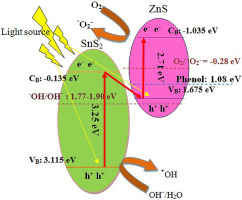当前位置:
X-MOL 学术
›
Solid State Sci.
›
论文详情
Our official English website, www.x-mol.net, welcomes your
feedback! (Note: you will need to create a separate account there.)
An effective wastewater treatment based on sunlight photodegradation by SnS2–ZnS/clinoptilolite composite
Solid State Sciences ( IF 3.4 ) Pub Date : 2020-03-01 , DOI: 10.1016/j.solidstatesciences.2020.106127 Hadis Derikvandi , Alireza Nezamzadeh-Ejhieh
Solid State Sciences ( IF 3.4 ) Pub Date : 2020-03-01 , DOI: 10.1016/j.solidstatesciences.2020.106127 Hadis Derikvandi , Alireza Nezamzadeh-Ejhieh

|
Abstract The SnS2–ZnS/clinoptilolite nanoparticles (SnS2–ZnS/NC) was used for the effective photodegradation of an oil refinery wastewater sample contained phenol as the major component. Band gap energy of SnS2/NC (3.28 eV) showed a considerable red shift with respect to ZnS–SnS2/NC (2.9 eV). Mole ratio of the semiconductors in the coupled system played an important role in the activity of the resulted composite, so the SnS2-ZnS-NC system containing 0.65 mol ZnS and 0.35 mol SnS2 (ZnS/SnS2: 1.85) showed the best photocatalytic activity. This confirms the best charge carriers’ separation occurred between the semiconductors in the composite. The RSM results showed acidic pHs at longer irradiation times, higher catalyst dosage and lower concentration of the pollutant caused to increase in the degradation extent. The best run included pH 4, catalyst dose of 2.3 g L−1, 10 folds diluted wastewater at irradiation time of 60 min. The photodegradation pathway was a direct Z-scheme mechanism and the following trend was obtained in the role of the reactive species in phenol degradation: Holes> OH > electrons> O2−.
中文翻译:

基于 SnS2–ZnS/斜发沸石复合材料的阳光光降解的有效废水处理
摘要 SnS2-ZnS/斜发沸石纳米颗粒(SnS2-ZnS/NC)用于有效光降解以苯酚为主要成分的炼油厂废水样品。SnS2/NC (3.28 eV) 的带隙能量相对于 ZnS-SnS2/NC (2.9 eV) 显示出相当大的红移。耦合体系中半导体的摩尔比对所得复合材料的活性起重要作用,因此含有 0.65 mol ZnS 和 0.35 mol SnS2 (ZnS/SnS2: 1.85) 的 SnS2-ZnS-NC 体系表现出最好的光催化活性。这证实了复合材料中半导体之间发生的最佳电荷载流子分离。RSM 结果表明,在较长的辐照时间、较高的催化剂剂量和较低的污染物浓度下,酸性 pH 值会导致降解程度增加。最佳运行包括 pH 4,催化剂剂量为 2.3 g L-1,在 60 分钟的辐照时间将废水稀释 10 倍。光降解途径是一种直接的 Z 方案机制,在苯酚降解中反应性物质的作用中获得了以下趋势:空穴> OH > 电子 > O2-。
更新日期:2020-03-01
中文翻译:

基于 SnS2–ZnS/斜发沸石复合材料的阳光光降解的有效废水处理
摘要 SnS2-ZnS/斜发沸石纳米颗粒(SnS2-ZnS/NC)用于有效光降解以苯酚为主要成分的炼油厂废水样品。SnS2/NC (3.28 eV) 的带隙能量相对于 ZnS-SnS2/NC (2.9 eV) 显示出相当大的红移。耦合体系中半导体的摩尔比对所得复合材料的活性起重要作用,因此含有 0.65 mol ZnS 和 0.35 mol SnS2 (ZnS/SnS2: 1.85) 的 SnS2-ZnS-NC 体系表现出最好的光催化活性。这证实了复合材料中半导体之间发生的最佳电荷载流子分离。RSM 结果表明,在较长的辐照时间、较高的催化剂剂量和较低的污染物浓度下,酸性 pH 值会导致降解程度增加。最佳运行包括 pH 4,催化剂剂量为 2.3 g L-1,在 60 分钟的辐照时间将废水稀释 10 倍。光降解途径是一种直接的 Z 方案机制,在苯酚降解中反应性物质的作用中获得了以下趋势:空穴> OH > 电子 > O2-。










































 京公网安备 11010802027423号
京公网安备 11010802027423号